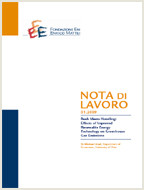Carbon Emissions Trading in China: The Evolution from Pilots to a Nationwide Scheme

Data
30.04.2015
30.04.2015
Autori
ZhongXiang Zhang (College of Management and Economics – Tianjin University, School of Economics – Fudan University)
Codice JEL
H23, O13, P28, Q43, Q48, Q52, Q54, Q58
H23, O13, P28, Q43, Q48, Q52, Q54, Q58
Parole chiave:
Pilot Carbon Trading Schemes, Environmental Taxes, Compliance, Carbon Offsets, Energy Prices, China
Pilot Carbon Trading Schemes, Environmental Taxes, Compliance, Carbon Offsets, Energy Prices, China
Publisher
Climate Change and Sustainable Development
Climate Change and Sustainable Development
Editor
Carlo Carraro
Carlo Carraro
The Chinese central government has approved the seven pilot carbon trading schemes. These seven pilot regions are deliberately selected to be at varying stages of development and are given considerable leeway to design their own schemes. These pilot trading schemes have features in common, but vary considerably in their approach to issues such as the coverage of sectors, allocation of allowances, price uncertainty and market stabilization, potential market power of dominated players, use of offsets, and enforcement and compliance. This article explains why China opts for emissions trading, rather than carbon or environmental taxes at least initially, discusses the key common and varying features of these carbon trading pilots and their first-year performance, draws the lessons learned, discusses the potential pathways for evolution of regional pilot carbon trading schemes into a nationwide carbon trading scheme, and raises fundamental issues that must be addressed in order to make such an emissions trading scheme to work reliably and effectively and with an increasingly expanded coverage and scope.
***
Suggested citation: Zhang, Z., (2015), ‘Carbon Emissions Trading in China: The Evolution from Pilots to a Nationwide Scheme’, Nota di Lavoro 38.2015, Milan, Italy: Fondazione Eni Enrico Mattei
